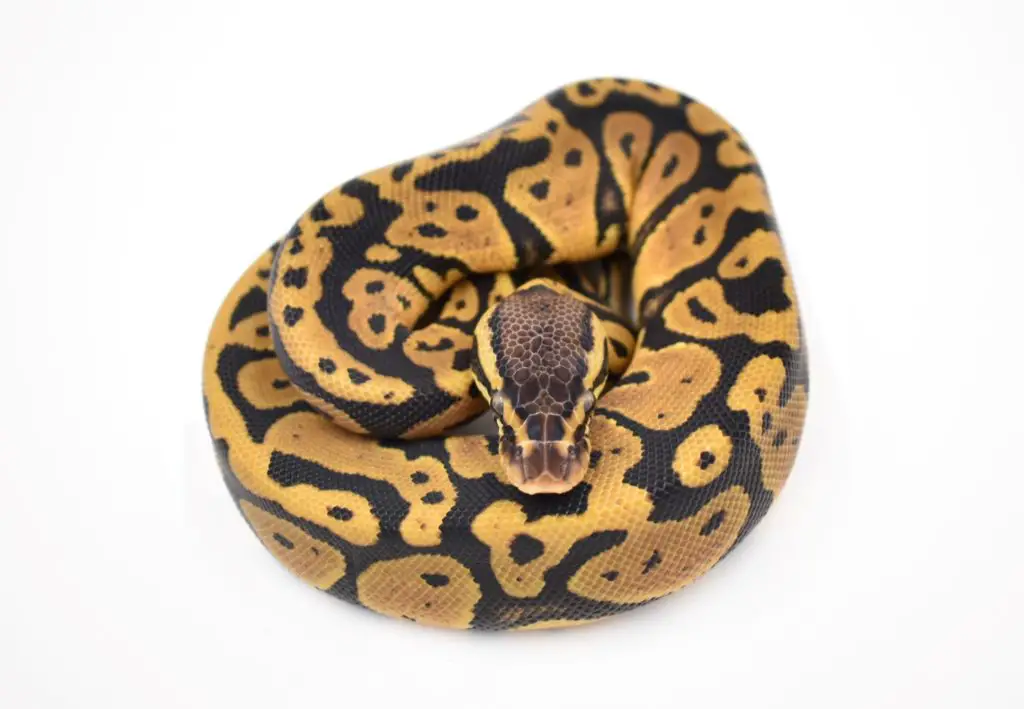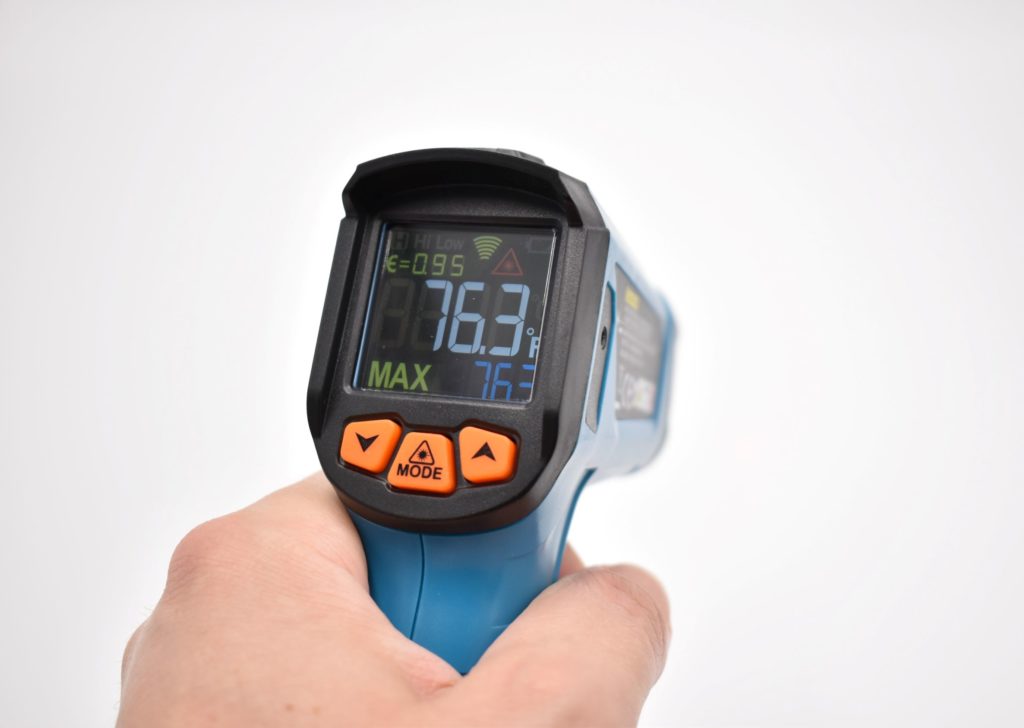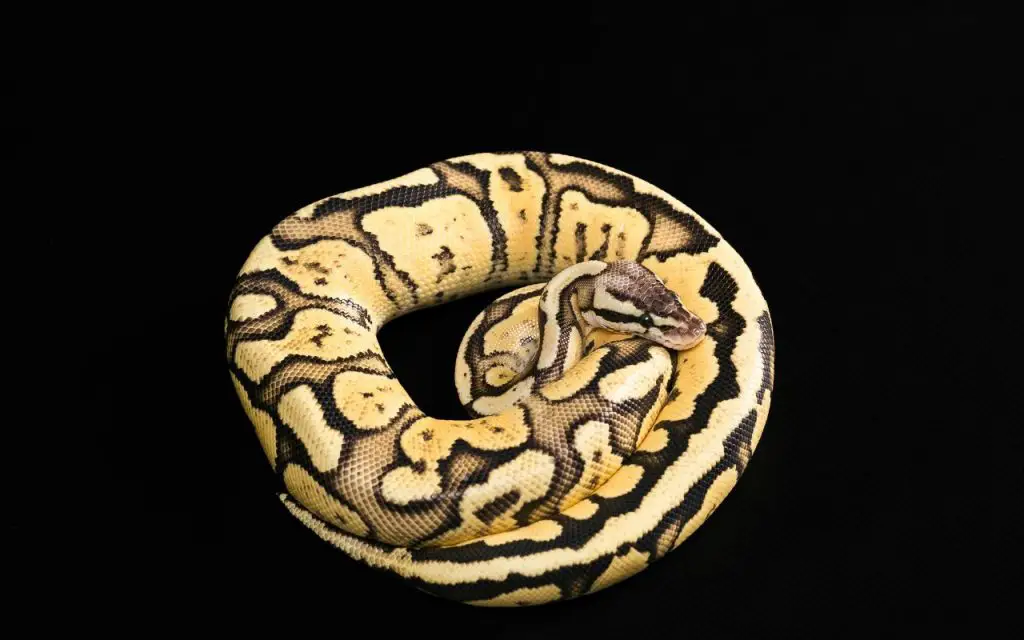Learning about the correct temperature for a Ball Python is key to keeping them healthy in captivity. Keep reading for an in-depth look at the subject…
Getting the temperature right for Ball Pythons is integral to their health and longevity. The more stable and optimal the temperatures are, the longer your pet will live. This means 90-91F (32C) at the warm end of the enclosure and 80-81F (27C) at the cool end, with only slight drop at night.
Ideal temp and humidity for Ball Pythons
When it comes to temperatures for reptiles, it’s about a lot more than just making them feel comfortable. It’s about providing temperatures that allow their metabolism and immune system to function correctly.
In equatorial (or nearly) reptiles like the Ball Python, this temperature also needs to be nice and stable to mimic the reliable, year-round warmth of the region. They don’t have the cold tolerance of Garter Snakes, for example.
This is so important, in fact, that failing to providing correct temperatures can lead to lowered feeding response, stress, suppression of the immune system and disease.
At this point, I should also mention that most reptiles need a temperature gradient, Ball Pythons included. This gives them an additional opportunity to regulate their body temperature, and is done simply by having a warm end and a cool end in the enclosure.
Check out the table below for the ideal day and night temperatures:
| Ideal temperature range | Warm end | Cool end |
| Day: | 90-91F (32C) | 80-81F (27C) |
| Night: | 86-87F (30C) | 76-77F (25C) |
When it comes to the slight night time drop in temperature, don’t worry too much about this! Heat at day time levels is better than no heat at all. When they have a cool end, all they have to do is move over to it if they feel too warm, whatever the time may be.
As far as humidity goes, this just as simple: Ball Pythons like a humidity level of 55-65%. This should be maintained at all times except for when they are in the final stages of shedding.
When that time comes, you can raise it to 80% to help them through the process. Obviously, I’m mentioning humidity a lot because reptiles truly function best with optimal temperatures and humidity.

Ball Python temperature Celsius
Something I find really annoying (and confusing) is when I read one care sheet with temperatures in Fahrenheit and another in Celsius. This happens a lot these days because some sites are run by people like me, who grew up with Fahrenheit, and yet others are run by those who grew up with Celsius.
There’s also a growing number of sites that now use Celsius because it is used by the international scientific community. Personally, I just provide both, so everyone gets the necessary husbandry information in a way they’re comfortable with.
I’ve actually seen some very scientific people kill reptiles and their clutches through lack of hands-on herpetocultural experience, so I’m a little past caring about how “scientific” anything is!
All this to say I’ve added a Fahrenheit to Celsius converter below. Bookmark this page, then come back anytime you need to. Problem solved!
Celsius to Fahrenheit calculator

Ball Python temperature at night
With ground-dwelling reptiles from equatorial climates its vital to provide a similar level of warmth at night. Where Ball Pythons live in west and central Africa it does get reasonably cool at night – sometimes as low as 72F (22C).
What you must remember, though, is that it also gets incredibly hot during the day. Temperatures can soar to 102F (39C) in Bolgatanga, Ghana, for example.
So what you end up with is very, very warm ground. When Ball Pythons come out to forage after dark, they are in contact with cool air, but nice belly heat from the earth they crawl over.
Heat is also retained in the rodents burrows and similar refugia they use for cover. This means if a Ball Python gets too cool at night, it can go a foot or so below the ground and warm up again.
When you look at it this way, it makes you realise why they enjoy lying on heat mats so much. More importantly, it makes you realise that they do need warmth at night.
All-in-all, my advice is to aim for a warm end temperature of 86-87F (30C), and cool end temperature of 76-77F (25C) at night.

Ball Python night temperature Celsius
Obviously, 30C at the warm end and 25C at the cool end is optimal for this species. But Ball Pythons really don’t seem to be too fussy about this. You won’t get a sick Ball Python because its temperature doesn’t drop at night – though this is possible with more sensitive species.
Personally, I don’t worry too much about a night time drop in temperature for my snakes. The room I keep them in naturally falls about 4F (2C) at night, and the ambient temperatures in their enclosures do likewise.
Luckily for me, this is ideal. If you have your snakes in a room that tends to build up heat during the day, or get very cool at night, you can regulate their temperatures by switching from a regular thermostat to one which also has a night time setting.
If you find that your snakes are consistently too cool at night, it might be wise to put an oil-filled radiator in the room to take the edge off. From my experience, the DeLonghi radiators are cost effective and free from harmful coatings (you can easily find them on Amazon).
*You should already be using an on/off or pulse-proportional thermostat for a heat mat, heat panel or ceramic heat emitter. For a day or night heat lamp you should be using a dimming thermostat.

Ball Python basking temp
Something you often see referenced in care sheets is basking temp. This means the temperature directly below or above a heat source.
Just because many people provide heat mats rather than heat lamps or ceramic heat emitters, it doesn’t mean that the temperatures referenced are incorrect. Any time you see “basking temp”, just remember that it is the same as when I say “warm end”.
In a nutshell, the basking temp is the temperature you should aim for in the portion of the enclosure nearest the heat source. For Ball Pythons, this happens to be around 90-91F (32C).
This warm area should cover roughly 30-40% of the enclosure floor. This is especially easy to figure out if you do use a heat mat, but you can still figure it out by checking surface temperatures near other heat sources with an infrared thermometer gun to see how wide an area is being warmed up.
In addition, there should always be hiding places (hides) both in the basking area, or warm end, and in the cool end.
Check out the floor space calculator below to figure if your basking spot is too big or too small. Remember, the floor space of your enclosue = length x depth (front to back). For example, the floorspace of a 36inch by 12inch enclosure would be 36×12=432inch²

Ball Python humidity
As I mentioned earlier in the article, humidity and temperature go hand-in-hand, and you can’t have a healthy snake without providing both. If you have perfect temperatures but low humidity, your snake will still be uncomfortable and have difficulty shedding.
Something that is particularly important to remember though, is that high humidity is very dangerous when combined with low temperatures. If your humidity is consistently higher than 65% and your temperatures consistently low, this is a recipe for disaster – or disease – to be precise.
Low temps and high humidity can lead to:
- Scale rot (necrotizing dermatitis)
- Respiratory infections
- Immunosuppression
The last item on the list – immunosuppression, means a weak or disabled immune system, that leads to heightened fragility and susceptibility to illness.

How to mitigate low humidity from heat sources
Something you’ll notice when aiming for that nice 55-65% is that it can be tough to achieve if you’re using a heat lamp or ceramic heat emitter. These heat sources dry out the air, and lower overall humidity.
This is unfortunate, but you can offset the problem by using the following tactics:
- Use a substrate that naturally holds humidity well. Examples include coco husk, cypress mulch and orchid bark.
- Spray the enclosure regularly. Spraying can help raise both the ambient humidity and that of the substrate.
- Provide humid hides. This is simple: put slightly damp sphagnum moss inside a hiding place. Not all snakes will use them but it’s a great solution for ones that will.
- Provide heavy, resin hides like the Exo Terra Reptile Caves (or similar brands). These are thick and naturally hold some humidity when the snakes are inside them.

What temperature will kill a Ball Python?
Some temperatures are likely to kill a Ball Python quickly through hyperthermia (too hot) or hypothermia (too cold). The result is the same: a shutdown in bodily functions and respiratory failure.
There’s no conclusive studies done on this, but based on my knowledge of similarly-sized reptiles I would consider any temperature above 130F (54C) or below 55F (13C) potentially deadly. This obviously depends on the size of the snake, and how long it is exposed.
In captivity, they should never be exposed to temperatures anywhere close to these! Always aim to keep the temperatures in the ranges listed in this article, to within a couple of degrees.

What temperatures will make your snake sick?
Incorrect temperatures can kill in the long run, even if they’re only off by around 5 degrees. It sounds like a small difference, but it’s true.
Snakes are poikilothermic, meaning they actively use their environment to regulate their body temperature. They don’t have any internal mechanism like we do to burn energy and convert it into heat.
This is pretty inconvenient for them, as their metabolism and immune system only function well if they are warm enough.
After a while, Ball Pythons kept at less that 80F (26C) get sick. Their immune system is on a go-slow and they become immunosuppressed, meaning that it really isn’t functioning anymore.
More often than not, this results in respiratory infections that require immediate treatment from either a specialist exotics vet or a very experienced breeder.
It isn’t just low temperatures that cause illness though. Some studies have found that reptiles become immunosuppressed at high temperatures, also.

FAQ relating to Ball Python temperature
What temperature do ball pythons prefer?
Ball Pythons prefer temperatures in the 90-91F (32C) range at the warm end of their enclosure and roughly 80-81F (27C) at the cool end. At these temperatures they should be active and healthy. Be sure to monitor these temperatures with either digital thermometers or an infrared thermometer gun.
How hot is too hot for a ball python?
Temperatures above 95F (35C) are too hot for a Ball Python. If you notice that your snake is excessively restless and even tries to escape during the day, then this is often a sign it is too warm. Make sure that your heat source is connected to a thermostat and that you double check temperatures with a separate thermometer.
Is 80 degrees a good temp for a ball python?
80F is a good temperature for the cool end of a Ball Python’s enclosure. The warm end, on the other side, should be at least 88F (31C), and preferably 90-91F (32C). These temperatures can vary a little, but an acceptable range is 78-83F (25-28C) at the cool end and 88-93F (31-34C) at the warm end.
Also on this topic:
For more on temperatures in general:
Back to the heat and light topic page
